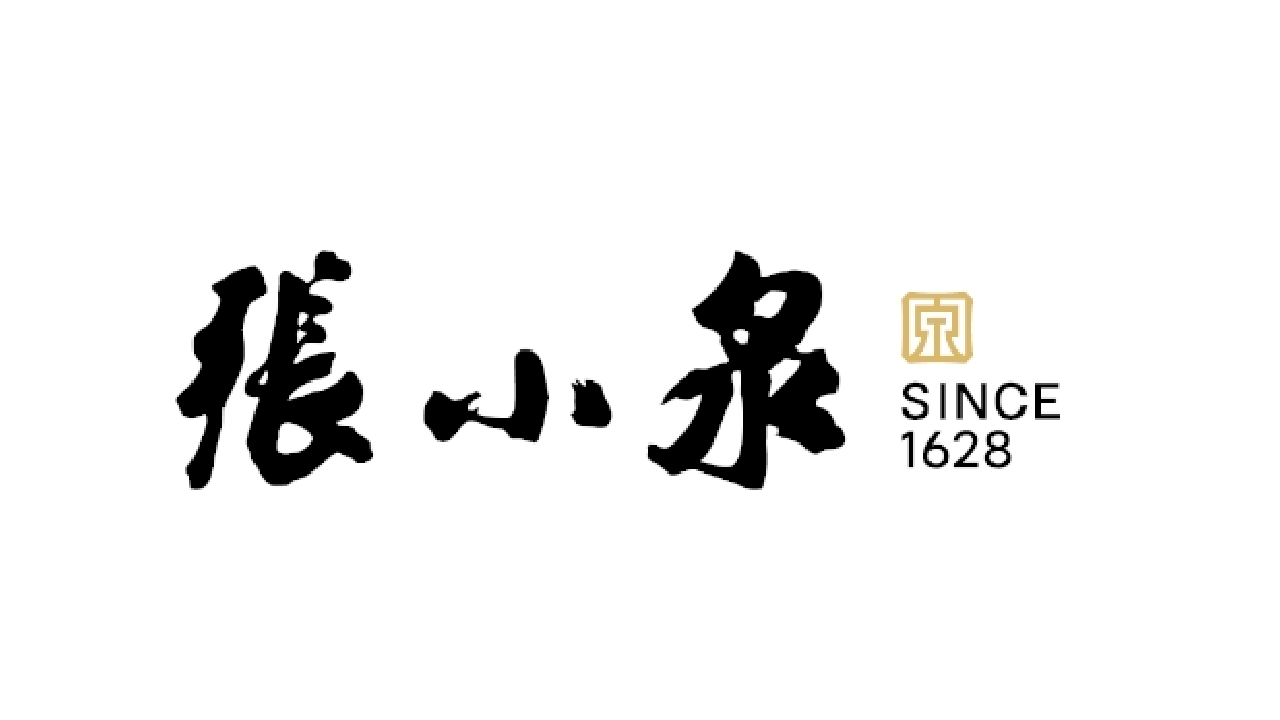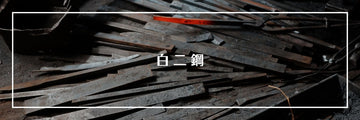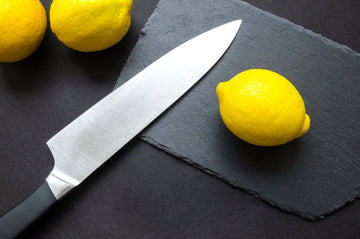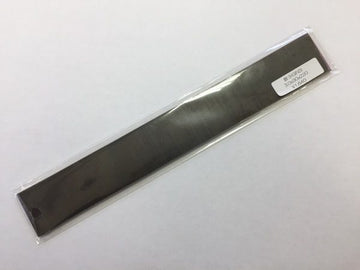White Steel #2 (Shirogami 2) is like a perfectly tuned musical instrument - nothing complicated, just pure and honest steel that cuts with remarkable precision. It represents the essence of traditional Japanese knife craftsmanship.

What White Steel 2 Is Made Of
White Steel 2 follows a philosophy of simplicity and focus. Made by Hitachi Metals, this steel contains:
- Carbon: 1.05-1.15% (this is what gives it exceptional sharpness)
- Manganese: A small amount (0.20-0.30%) to help it harden properly
- Silicon: Minimal addition (0.10-0.20%) for strength
- Almost nothing else: Extremely low phosphorus (≤0.025%) and sulfur (≤0.004%)

The name "White Steel" comes from the appearance of the steel when etched during production - showing a clean, bright surface that reflects its purity. Unlike modern steels that gain performance through various alloying elements, Shirogami 2 achieves its legendary status through what it doesn't contain, maintaining an almost singular focus on the relationship between iron and carbon.
How White Steel 2 Performs In The Kitchen
Hardness, Toughness And Edge Properties
White Steel 2 achieves an impressive hardness of 60-63 HRC after proper heat treatment. This exceptional hardness, higher than most Western kitchen knives, is what allows it to take such a keen edge. Yet unlike some hard steels that become brittle, White Steel 2 maintains a certain resilience when properly heat-treated. It's like an old tree that stands firm against strong winds but can still bend slightly instead of snapping.

The steel's fine, uniform microstructure - with minimal impurities and secondary carbides - means it can be ground to extremely acute edge angles of 15-17 degrees per side, with some master sharpeners even achieving angles as low as 10 degrees for specialized tasks.
Sharpness And Edge Retention
The first time you use a properly sharpened White Steel 2 knife, you might laugh out loud. Not because it's funny, but because it's surprising – like hearing a beautiful song when you expected ordinary noise. The blade doesn't push through food; it falls through it, as if the vegetables and meat are eager to be cut.
One chef told me, "Using a White Steel 2 knife is like suddenly finding out you've been writing with a brick all your life, and someone just handed you a fountain pen."
The edge doesn't stay sharp forever – after about 5 kilograms of vegetables or 6-8 hours of professional use, you'll need to sharpen it again. But here's the secret: sharpening this steel is almost a pleasure. It takes 30% less effort than Blue Steel (Aogami) and responds to your stones like a child eager to learn.
Many chefs actually look forward to sharpening their White Steel 2 knives – it becomes a quiet moment in their busy day, like drinking tea under a tree.
Reactivity And Care Requirements
Of course, everything valuable has its cost. White Steel 2 has no chromium to fight rust, so it reacts quickly to moisture and acids. Cut a lemon and walk away, and you'll return to find your blade spotted with orange tears.

When you use these knives, you must:
- Wipe them clean after cutting each ingredient
- Wash them gently by hand (never in a dishwasher, which would be like throwing a silk shirt into boiling water)
- Dry them immediately and completely
Over time, your knife will develop a blue-gray patina – like an old man's face showing the lines of his experiences. This natural layer actually helps protect the blade, and many chefs see it as a beautiful record of all they've cooked.
"My White Steel 2 knife knows more about what I've cooked than my own memory," one chef said to me, showing me his blade's dark, mottled surface with pride.
White Steel 2 Applications In Kitchen Knives
Traditional Japanese Knife Styles
The most beautiful expressions of White Steel 2 are in traditional Japanese knife designs:
-
Yanagiba: Long knives (240-300mm) for slicing raw fish. When a sushi chef cuts with a Shirogami 2 yanagiba, the fish doesn't even know it's been cut until it finds itself on the rice.

-
Deba: Heavier knives for breaking down fish. The clean, precise edge separates flesh from bone like memories separating from dreams.

-
Honyaki: These are the most prestigious knives, made from a single piece of White Steel #2. They show beautiful wavy lines (hamon) on their blades, like the pattern a small boat leaves in still water.

Modern Knife Designs
Today's chefs also use White Steel 2 in newer knife styles:
-
Gyuto: The Japanese version of a chef's knife, it handles everything from vegetables to meat with equal precision.

-
Santoku: All-purpose knives whose name means "three virtues" – cutting meat, fish, and vegetables equally well.

-
Petty knives: Small utility knives that perform delicate tasks like a skilled calligrapher drawing fine characters.

Comparison With Other Kitchen Knife Steels
White Steel 2(Shirogami 2) vs. White Steel 1(Shirogami 1)
| Property | White Steel 2 | White Steel 1 |
|---|---|---|
| Carbon content | 1.05-1.15% | 1.25-1.35% |
| Hardness (HRC) | 60-63 | 62-64 |
| Grain structure | Fine-grained martensite | Very fine-grained martensite |
| Edge retention | Good | Slightly better (+10-15%) |
| Toughness | Moderate | Lower (more brittle) |
| Sharpening ease | Excellent | Good, but requires more technique |
White Steel 2 represents the purest form of Japanese carbon steel with its higher carbon content, which enables maximum potential hardness and edge-taking ability. The increased carbon creates more carbides in the steel matrix, contributing to better edge retention but also making the steel more prone to chipping and microchipping. Metallurgically, White Steel 1 forms finer carbide structures but also experiences greater internal stress during heat treatment, requiring more precise tempering to prevent brittleness.
White Steel 2(Shirogami 2) vs. White Steel 3(Shirogami 3)
| Property | White Steel 2 | White Steel 3 |
|---|---|---|
| Carbon content | 1.05-1.15% | 0.80-0.90% |
| Hardness (HRC) | 60-63 | 58-60 |
| Grain structure | Fine-grained martensite | Coarser martensite with ferrite |
| Edge retention | Good | Moderate (-25-30%) |
| Toughness | Moderate | Good (+20-25%) |
| Sharpening ease | Excellent | Very easy |
White Steel 3's lower carbon content results in a steel with fewer carbides and more ferrite in its microstructure, significantly increasing toughness at the expense of hardness and edge retention. The steel's microstructure shows larger carbide formations and more ferrite regions, which prevents crack propagation but limits maximum keenness. Heat treatment is less demanding for White Steel 3, with a wider temperature range for quenching and tempering, making it more forgiving for both bladesmiths and users.
White Steel 2(Shirogami 2) vs. Blue Steel 2(Aogami 2)
| Property | White Steel 2 | Blue Steel 2 |
|---|---|---|
| Carbon content | 1.05-1.15% | 1.05-1.15% |
| Chromium | Trace amounts | 0.2-0.5% |
| Tungsten | None | 1.0-1.5% |
| Molybdenum | None | 0.2-0.5% |
| Hardness (HRC) | 60-63 | 61-64 |
| Carbide structure | Simple Fe₃C carbides | Complex carbides (Fe₃C, WC, Mo₂C) |
| Edge retention | Good | Excellent (+30-40%) |
| Corrosion resistance | Poor | Poor, but slightly better |
| Sharpening ease | Excellent | Moderate (requires 25-30% more effort) |
Blue Steel 2's distinguishing feature is its alloying elements, particularly tungsten and chromium, which form complex carbides that remain undissolved during heat treatment. Electron microscopy reveals these carbides are harder and more wear-resistant than the simple iron carbides found in Blue Steel 2. The tungsten carbides significantly enhance edge stability during prolonged cutting tasks, while slightly increasing the steel's density by approximately 2-3%. Chromium offers marginally improved corrosion resistance by forming a thin passive layer, though both steels still require immediate maintenance after exposure to moisture or acids.
White Steel 2(Shirogami 2) vs. VG-10
| Property | White Steel 2 | VG-10 |
|---|---|---|
| Carbon content | 1.05-1.15% | ~1.0% |
| Chromium | Trace amounts | ~15% |
| Other elements | Minimal | Co, Mo, V |
| Hardness (HRC) | 60-63 | 60-62 |
| Microstructure | Homogeneous martensite | Martensite with chromium carbides |
| Edge retention | Good | Very good (+20-25%) |
| Corrosion resistance | Poor | Excellent (+900%) |
| Sharpening ease | Excellent | Difficult (requires 80-100% more effort) |
| Edge refinement | Exceptional | Very good (90-95% of Shirogami 2) |
VG-10 is fundamentally different from Shirogami 2 due to its high chromium content, which classifies it as a stainless steel (defined as containing >10.5% Cr). The chromium forms a self-healing chromium oxide layer that provides substantial corrosion protection, while the vanadium and molybdenum create hard carbides that enhance wear resistance. Metallographic analysis shows VG-10's carbides are larger and more dispersed throughout the matrix compared to Shirogami 2's fine, evenly distributed carbides. This affects edge geometry at the microscopic level, with VG-10 unable to achieve the same degree of apex refinement as Shirogami 2, though the difference is imperceptible to all but the most demanding cutting applications.
Taking Care Of White Steel 2 Knives
Basic Maintenance
Caring for a White Steel 2 knife is like caring for a good relationship – small, regular attentions prevent big problems:
- Wipe the blade clean after cutting each ingredient, especially acidic ones
- Wash with mild soap and warm water
- Dry immediately and completely with a soft cloth
- Apply a thin coat of camellia oil or food-safe mineral oil weekly
- Store in a wooden sheath (saya) to protect it from moisture and damage
Many chefs keep a dedicated towel just for their carbon steel knives. "It's not extra work once it becomes habit," they tell me. "It's just part of cooking, like tasting as you go."
Sharpening Recommendations
One of the greatest joys of owning a White Steel 2 knife is how wonderfully it sharpens:
- Medium stones (1000-2000 grit) work well for regular maintenance
- Finishing with fine stones (3000-6000 grit) brings out the steel's true potential
- The steel tells you when you're doing it right – it almost sings under the stone
Even beginners can achieve impressive results because Shirogami 2 is so responsive during sharpening. It's like teaching a child who learns quickly – even your mistakes become valuable lessons.
Conclusion
White Steel 2 (Shirogami 2) is like an old folk song – simple, direct, and somehow more powerful than complicated modern music. Its carbon-rich, pure composition creates a blade that cuts with a clarity that can change how you experience cooking.
Yes, it requires more care than stainless steel knives. Yes, you must wipe it clean and keep it dry. But for many chefs and home cooks, this relationship with their knife deepens their connection to cooking itself. The knife becomes not just a tool but an extension of their hands and intentions.
In my village, we had a saying: "The thing that asks for your care gives the most in return." A White Steel 2 knife asks for your attention but gives back a cutting experience that makes everyday cooking feel like art.
Like a special knife that cuts watermelon as if by magic, a Shirogami 2 blade offers a simple perfection that stays in your memory long after the meal is finished. In a world full of complicated things that promise convenience, there's something deeply satisfying about a tool that achieves greatness through purity and focus rather than endless features.
For those willing to give it the care it needs, White Steel #2 isn't just a knife – it's a daily reminder that sometimes the simplest things cut most truly.
Here are the 10 question-and-answer pairs with proper line breaks between questions and answers:
What is white #2 steel?
White Steel #2 (Shirogami 2) is a high-carbon Japanese knife steel made by Hitachi with 1.05-1.15% carbon content. It contains minimal alloying elements, offering exceptional sharpness and ease of sharpening but poor corrosion resistance. It typically achieves 60-63 HRC hardness when properly heat treated.
White steel 2 vs 3
White Steel #2 has higher carbon content (1.05-1.15%) than White Steel #3 (0.80-0.90%), making it harder (60-63 HRC vs 58-60 HRC) with better edge retention. White Steel #3 offers more toughness and is less prone to chipping, making it more forgiving for beginners, while White Steel #2 can achieve a sharper edge.
What is the difference between white #1 and #2 steel?
White Steel #1 has higher carbon content (1.25-1.35%) than White Steel #2 (1.05-1.15%), enabling slightly better edge retention and higher potential hardness (62-64 HRC vs 60-63 HRC). However, White Steel #1 is more brittle and prone to chipping, while White Steel #2 offers a better balance of sharpness and durability.
White steel #2 vs blue steel #2
Both have similar carbon content (1.05-1.15%), but Blue Steel #2 contains chromium, tungsten, and molybdenum that White Steel #2 lacks. Blue Steel #2 offers 30-40% better edge retention but is 25-30% more difficult to sharpen. White Steel #2 achieves a slightly keener edge but has marginally worse corrosion resistance.
White 1 vs white 2 steel
White Steel #1 is the purest with highest carbon (1.25-1.35%), offering maximum potential sharpness but increased brittleness. White Steel #2 (1.05-1.15% carbon) provides better balance between sharpness and toughness. Most chefs prefer White Steel #2 for its more practical performance in daily use.
Is White Steel #2 good for kitchen knives?
White Steel #2 is excellent for kitchen knives, especially for precision cutting tasks. It takes an exceptionally sharp edge that enhances control and precision when cutting vegetables, fish, and meat. While it requires more maintenance than stainless steel, many professional chefs and enthusiasts prefer it for its superior cutting performance and tactile feedback during use.
How do you care for White Steel #2 knives?
Clean immediately after use, especially after cutting acidic foods. Wash by hand with mild soap, dry completely right away, and apply food-grade mineral oil or camellia oil weekly. Store in a dry place, ideally in a wooden sheath (saya). Never leave wet or put in dishwasher.
How often do White Steel #2 knives need sharpening?
With regular home use, White Steel #2 knives typically need sharpening every 1-2 months. Professional chefs may need to sharpen after 6-8 hours of continuous use or processing about 5kg of vegetables. The exact frequency depends on cutting technique, board material, and types of food prepared.
What are the best uses for White Steel #2 knives?
White Steel #2 excels at precision tasks requiring extreme sharpness: slicing raw fish for sashimi, fine vegetable work, and detailed garnish preparation. It's ideal for ingredients where clean cutting is critical to preserve texture and appearance. It's less suitable for cutting frozen foods, bones, or tasks requiring lateral blade pressure.
White Steel #2 vs VG-10 steel
White Steel #2 (1.05-1.15% carbon) has minimal alloying elements, while VG-10 contains ~15% chromium with vanadium, cobalt, and molybdenum. VG-10 offers 900% better corrosion resistance and 20-25% better edge retention, but White Steel #2 sharpens more easily and achieves a keener edge. Choose VG-10 for convenience, White Steel #2 for ultimate cutting performance.






